Ropinirole prescription: what to expect and how to stay safe
Need a clear take on ropinirole? This short guide tells you why doctors prescribe it, how dosing usually works, what side effects to watch for, and simple safety steps you can use right away. No fluff—just the practical stuff patients ask about most.
What ropinirole treats and how it works
Ropinirole is a dopamine agonist. Doctors commonly use it for Parkinson’s disease and restless legs syndrome (RLS). For Parkinson’s, it helps ease stiffness and slow movements. For RLS, it reduces the urge to move your legs and the uncomfortable sensations that wake you at night. Your doctor decides if ropinirole fits your symptoms after a medical check and by ruling out other causes.
Dosing, starting out and common side effects
Prescriptions usually start low and increase slowly. For RLS, a common start is 0.25–0.5 mg before bedtime, then your doctor raises it if needed. For Parkinson’s the starting dose is often a bit higher and split through the day. Follow your prescriber's schedule—don’t change doses on your own.
Expect mild side effects at first: nausea, dizziness, sleepiness, or lightheadedness when standing up fast. A smaller number of people report sudden sleep episodes, hallucinations, or impulse-control behaviors (like new gambling or shopping urges). If you notice sudden sleep attacks or new risky behaviors, tell your doctor right away.
There’s a real risk if you stop ropinirole abruptly. Symptoms can return or get worse. Your doctor will advise a slow taper when it’s time to stop.
Interactions and safety tips
Certain drugs change ropinirole levels. Fluvoxamine and ciprofloxacin can raise ropinirole in your blood. Smoking can lower it. Tell your provider about all meds, supplements, and if you smoke. Avoid heavy alcohol while on ropinirole—alcohol can increase sleepiness and dizziness.
Drive or operate machinery only if you feel alert. If ropinirole makes you drowsy or causes sudden sleep, do not drive. Keep a symptom diary for a week or two after starting or changing dose—note sleepiness, mood changes, urges, and symptom control. That helps your doctor fine-tune treatment.
Buying ropinirole? You need a prescription. Use a licensed pharmacy and check reviews or accreditation if you shop online. Avoid offers that skip a doctor’s check—those are risky.
When to get emergency help: high fever, severe rash, breathing trouble, chest pain, or fainting. For less urgent problems like ongoing nausea or new mood changes, call your prescriber and ask for advice or a dose adjustment.
Final tip: regular check-ins matter. A short phone call or clinic visit after dose changes catches problems early and keeps your treatment working safely.




